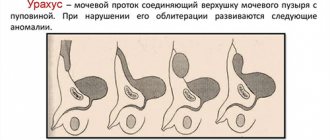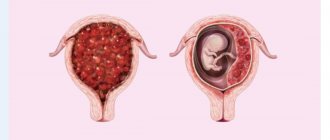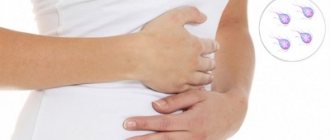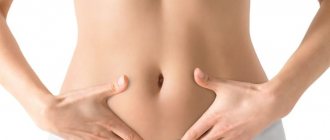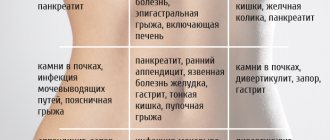Possible complications
With a significant accumulation of fluid in the abdomen, the functionality of the internal organs is impaired.
This applies not only to the abdominal organs, but also to the respiratory system. Restricted mobility of the diaphragm leads to pulmonary insufficiency and the formation of effusion in the pleural cavity. An increase in pressure in the hepatic portal vein system entails the passage of bacteria from the intestine into ascitic fluid, provoking the development of spontaneous bacterial peritonitis.
The terminal (last) stages of ascites entail a serious complication - hepatorenal syndrome. The concept implies a dysfunction of the excretory system up to renal failure. The exact reason for the development of this condition is not fully understood. Doctors believe that it occurs due to damage to the renal bloodstream, excessive use of diuretics and intravenous contrast.
Recommendations for the second trimester of pregnancy
Most recommendations are universal for all trimesters, for example, giving up bad habits, sleeping for 8-9 hours and eating well. But there are some important tips that apply specifically to the second trimester.
- You should only sleep on your side and use a special pillow for pregnant women.
- From the 24th week, it is advisable to start wearing a bandage, this will help reduce the load on the spinal column.
- Avoid contact with people who are sick or have a cold. If the second trimester falls during the “cold season,” try to spend less time in crowded places.
- Take vitamin and mineral supplements, even if you haven't done so before. Right now, the need for vitamins and minerals is increasing somewhat, especially iron, as well as omega-3 PUFAs, which are needed for the formation and proper development of the child’s brain, nervous and immune systems.
- Switch to proper nutrition. The second trimester is a time of active fetal growth; diets and fasting are inappropriate now. But it is important not to get carried away with fast food, to make sure that the menu has enough proteins and seasonal vegetables and fruits.
What causes ascites to develop in cancer?
Pathological fluid accumulates in the peritoneum when the following organs are affected by the oncological process:
- appendages, ovaries;
- mammary gland;
- uterus;
- stomach;
- large intestine (mostly large intestine).
Ascites in oncology occurs due to the fact that the inner layer of the abdominal cavity (peritoneum) and the membrane covering the organs located in it are affected.
Malignant cells attach to the parietal and visceral layers of the peritoneum, which leads to impaired lymphatic drainage and impaired fluid absorption. The main causes of the pathological condition are neoplasms of the gastrointestinal tract (gastrointestinal tract) and tumors of the female reproductive system.
When liver tissue is damaged by cancer cells, another mechanism for the development of dropsy occurs. The venous system of the liver is pinched, disrupting venous circulation in the intestinal area. This option is more difficult and takes much longer. A sixth of the cases of fluid accumulation in the abdominal cavity in oncological pathologies occur in the form described above.
The cause of ascites in abdominal lymphoma is blockage and leakage of lymph from the intra-abdominal ducts.
How the belly grows
Let’s say right away that how the belly looks and grows during pregnancy depends on many reasons: the woman’s physique, the structure of the pelvis, the condition of the muscles, the growth of the uterus and child, the amount of amniotic fluid. Therefore, for some, the belly grows faster, for others slower, for some mothers it is large, for others it can be almost invisible. But still, there are some general patterns in the growth and size of the abdomen during pregnancy.
Rates of growth
1st trimester
As a rule, in the early stages of pregnancy, the belly does not increase in size or increases only slightly. This is due to the fact that the uterus is still very small and it takes up little space in the pelvis. So, for example, by the end of the 4th week the uterus reaches only the size of a chicken egg, by the 8th week it increases to the size of a goose, but most importantly, at this time it has not yet reached the symphysis pubis (located in the lower abdomen). That is why in the early stages no enlargement of the abdomen is visible. And only after the 12th week (the end of the first trimester of pregnancy) the fundus of the uterus begins to rise above the womb.
II trimester
At this time, the child sharply gains height and weight, and the uterus also grows rapidly. That is why, at 12–16 weeks, an attentive mother will see that the belly has already become noticeable. True, those around you will notice the woman’s new position at about 20 weeks, especially if she wears tight-fitting clothes.
III trimester
By the beginning of the third trimester, pregnancy is no longer in doubt. The belly is clearly visible even if a woman wears loose clothing.
Sharp, round, different
From approximately the second trimester of pregnancy, during each examination, the obstetrician-gynecologist determines the height of the uterine fundus and measures the abdominal circumference at the level of the navel. Why does the doctor so carefully monitor the enlargement of my mother’s tummy? The fact is that this is the easiest way to monitor the growth and development of the unborn baby.
One of the formulas for approximate estimation of fetal weight based on the height of the uterine fundus (UFHR):
child's weight (g) = VSDM (cm) x abdominal circumference (cm) ± 150–200 g
By the way, in the past they often tried to determine the gender of the child by the shape of the belly. It was believed that a round belly foreshadows a girl, and an elongated, oblong, “sharp” belly portends a boy. However, these predictions did not always come true, since the shape and size of the abdomen do not depend at all on the gender of the child.
- In large, tall women, the belly may be small and not very noticeable until advanced stages of pregnancy, but in thin, petite women (especially with a narrow pelvis or a large baby), the belly appears very large.
- The state of the muscle tone of the anterior abdominal wall and uterus has a significant influence on the shape of the abdomen. During your first pregnancy and good muscle tone, your stomach may look more “toned” than with subsequent pregnancies. In addition, with repeated pregnancies, as a result of reduced muscle tone of the anterior abdominal wall, the child does not occupy its final position until the last month of pregnancy. Because of this, the shape of the abdomen can also be “stretched”.
- If a woman is expecting twins, her belly will be larger than with a singleton pregnancy.
- And often the belly can be large simply because a woman stops restricting herself in nutrition and eats “for two.”
- If the child grows quickly or is large, then the mother’s belly may grow faster and be larger.
- Babies are positioned differently in the uterus. With some types of presentation, the belly will be less noticeable, with others it will begin to grow earlier and appear larger.
Feeling the tummy
The belly of the expectant mother changes not only in appearance. From the 20th week of pregnancy, the mother begins to feel the baby's movements
. At first they look like light flutters, but over time the movements become more intense, because towards the end of pregnancy the weight and size of the child increases, and now he is not as spacious in the uterus as before. The number of movements gradually decreases, but their strength increases.
The baby's movements, especially intense ones, can cause unpleasant sensations in a woman, especially in the right or left hypochondrium
.
This is explained by the fact that with a cephalic presentation (the baby is positioned head down in the uterus), the impacts of the baby’s legs are projected into the area of the mother’s internal organs: the liver, stomach, intestines and spleen. Such sensations and even pain are natural and do not require treatment.
And sometimes painful sensations appear in the sides of the abdomen.
They arise due to the fact that during pregnancy the ligaments that support the uterus and ovaries are stretched.
In addition, changes occur in the fallopian tubes (they thicken, blood circulation in them increases), in the ovaries (they increase somewhat in size, cyclic processes stop in them, and the position of the ovaries changes due to an increase in the size of the uterus). Mild painful sensations in the lower abdomen may occur several times during the day, but, as a rule, they quickly disappear if the woman takes a position that is comfortable for her. Sometimes periodic discomfort in the lower lateral parts of the abdomen appears due to constipation, which is also common in pregnant women: during pregnancy, hormones are produced that relax the uterus, and they have a similar effect on the intestines: its peristalsis is disrupted, resulting in constipation.
The belly can be large or small, protruding forward or as if blurred, located low or high - everything will depend on the individual characteristics of pregnancy.
How the belly grows and looks during pregnancy depends on many factors: the woman’s physique, the structure of the pelvis, the condition of the muscles, the growth of the uterus and child, and the amount of amniotic fluid.
Most often, the belly begins to grow after the 12th week of pregnancy, and others will be able to notice the woman’s interesting position only from the 20th week. However, everything is strictly individual, there is absolutely no exact definition of the timing of the appearance of the belly, it is simply impossible to predict.
Don’t be upset if the shape or size of your belly doesn’t match the average, because everything is individual. Focus on your constitution, the functioning of your body and the development of your baby.
REMINDER
At 4 weeks the uterus reaches the size of a chicken egg.
At 8 weeks - a goose egg.
At 12 weeks, the uterus reaches the upper edge of the pubic bone. The belly is not yet noticeable.
At 16 weeks, the belly is rounded, the uterus is located halfway between the pubis and the navel.
At 20 weeks, the abdomen is noticeable to others, the fundus of the uterus is 4 cm below the navel.
At 24 weeks, the fundus of the uterus is at the level of the navel.
At 28 weeks, the uterus is located above the navel.
At 32 weeks, the navel begins to smooth out. Abdominal circumference – 80–85 cm.
At 40 weeks, the navel protrudes noticeably. Abdominal circumference 96–98 cm
Diagnostic methods in Medscan
The Medscan clinic implements the latest diagnostic techniques for visualization and clinical analysis of the test fluid. The clinic’s doctors use the following methods in their work:
- Physical examination. Examination of the patient allows you to determine the approximate level of accumulated fluid.
- Biochemical blood test - assesses the condition of the hepatobiliary system (liver functionality) and kidneys. A blood test gives an idea of its coagulability and the level of electrolytes.
- X-ray and ultrasound examinations of the abdominal organs visualize the accumulated fluid.
- CT and MRI will clarify the presence of ascites.
- Laparocentesis - the doctor pierces the abdominal wall with a special needle and analyzes the ascitic fluid. The procedure helps to determine the cause of ascites. It also determines whether the fluid is infected and whether abnormal cells are present in it.
Pediatricians:
Avzalova Daria Evgenevna
Pediatrician, neonatologist
Experience: 17 years Reviews: 7
Call to home
Barzenok Tatyana Arsenyevna
Head of the pediatric department, pediatrician of the first category
Experience: 27 years Reviews: 17
Make an appointment Call at home
Belousova Elena Sergeevna
Pediatrician, nephrologist
Experience: 17 years Reviews: 14
Make an appointment Call at home
Bykov Mikhail Viktorovich
Pediatrician of the highest category, ultrasound diagnostics specialist, Candidate of Medical Sciences
Experience: 24 years Reviews: 3
Make an appointment Call at home
Kazakova Liliya Valentinovna
Pediatrician, neonatologist, head of the breastfeeding consultant service
Experience: 27 years Reviews: 31
Make an appointment Call at home
Sedova Maria Sergeevna
Pediatrician, allergist-immunologist
Experience: 19 years Reviews: 30
Make an appointment Call at home
Sergienko Tatyana Yakovlevna
Pediatrician, pediatrician on duty at the pediatric hotline
Experience: 38 years Reviews: 21
Make an appointment
Treatment methods in Medscan
Conservative therapy with diuretics is appropriate for the treatment of mild ascites. Up to 1 liter of fluid per day is removed in this way.
The main method of treating ascites in oncology is laparocentesis for therapeutic purposes (removal of pathological fluid). An exception is ovarian cancer. In such a case, cytoreductive surgery (removal of the maximum volume of the tumor and metastases) and chemotherapy are indicated.
For patients who are contraindicated for repeated laparocentesis, Medscan specialists prescribe peritoneal port systems and catheters. For people suffering from portal hypertension (with metastasis or carcinoma), doctors recommend diuretics - diuretics.
What should an expectant mother be wary of?
The second trimester is characterized by a large amount of discharge. Normally, they have a light white or yellowish tint, a uniform consistency, and no odor. Discharge becomes more abundant due to the fact that it is more difficult for the body to maintain normal microflora, compensatory mechanisms are launched.
However, the appearance of the discharge described below is not typical for a normal pregnancy:
- Brown. There is a risk of late miscarriage, premature birth and problems with the placenta.
- Greenish, gray. Indicate infectious processes of a purulent nature.
- White curdled ones. The microflora is disrupted and, as a result, thrush occurs.
If any unusual discharge occurs, you should consult a doctor.
